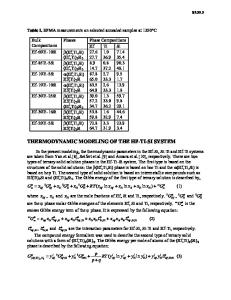Thermodynamic calculation of phase equilibria of the Bi-Sn-Zn system
- PDF / 140,213 Bytes
- 7 Pages / 612 x 792 pts (letter) Page_size
- 60 Downloads / 381 Views
Thermodynamic Calculation of Phase Equilibria of the Bi-Sn-Zn System Dmitri V. Malakhov, Xing Jun Liu, Ikuo Ohnuma, and Kiyohito Ishida
(Submitted 30 May 2000) A thermodynamic assessment of the Bi-Sn-Zn ternary system was carried out by considering the experimental data including the phase equilibria and thermodynamic properties on the basis of the CALPHAD method. A set of optimized thermodynamic parameters has been obtained, which leads to a very good fit between calculation and experiments. In particular, the thermodynamic calculations in the Sn-rich portion are presented in view of the recent progress in Pb-free solder alloys.
1. Introduction Numerous efforts have been undertaken in recent years to develop Pb-free substitutes for the lead-tin soldering alloys widely used in microelectronics. Systems containing Ag, Bi, Cu, In, Sb, Sn, Zn, and other elements have been the subjects of experimental investigation, but many of them remain unexplored. The methods of computational thermodynamics are known to be powerful tools to facilitate, accelerate, and simplify the search for proper Pb-free alloys. The Bi-Sn-Zn alloys are promising candidates for the development of Pbfree alloys. Although experimental investigations on phase equilibria of this system were carried out many years ago, thermodynamic assessment has not been carried out so far. As a part of the thermodynamic database for microsolder alloys [1999Ohn, 2000Ohn], the purpose of the present work is to make a thermodynamic assessment of the Sn-Bi-Zn system on the basis of the experimental data by the CALPHAD method [1998Sau].
2. Survey of Previous Works 2.1 Thermodynamic Properties Temperature and composition dependencies of the chemical potential of zinc in the liquid phase were investigated using mainly the electromotive force (EMF) technique [1959Ole, 1962Koz, 1966Pta, 1967Glu, 1968Lou, 1977Bal, 1985Mat], and magnitudes of errors were considered for optimization. Since ⌬Zn ⫽ ⫺2FE, a random error can be given as 2F⌬absE. Sometimes the reported accuracy of voltage measurements is unrealistically high, and thus, it was decided to use max (2F⌬absE앚 ⌬Zn앚 ⌬rel) as a more realistic estimation of random error. Dmitri V. Malakhov, Department of Materials Science and Engineering, McMaster University, Hamilton L8S 4M1, ON, Canada; and Xing Jun Liu, Ikuo Ohnuma, and Kiyohito Ishida, Department of Materials Science, Graduate School of Engineering, Tohoku University, Sendai 980-8579, Japan. Contact e-mail: [email protected].
514
Vapor pressures of zinc over Sn-Zn-Bi melts were measured by means of the Knudsen effusion method in the range of 317 to 387 ⬚C [1961Yok]. The gas phase was assumed to contain only monomers, and the chemical potential LZn ⫽ RT ln (PZn /P⬚Zn) was evaluated with the dependence P0Zn(T ). The reported relative accuracy of pressure measurements is 3.24%; errors of temperature and composition were assumed to be 2 K and 0.001.
2.2 Phase Diagram Experimental investigations of the Bi-Sn-Zn phase diagram date from the end of the ninete
Data Loading...











